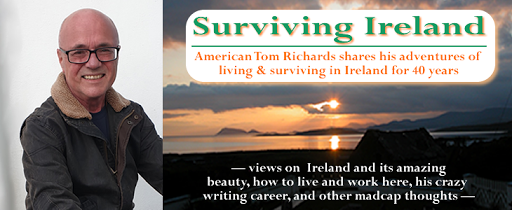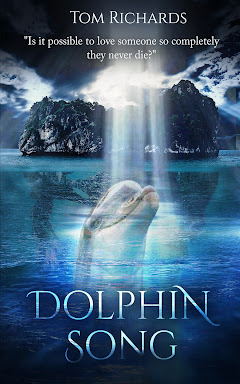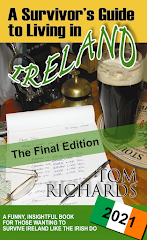As of next month this Chicago-born Yank has lived in Ireland
for 35 years. For much of that time I called County Meath – an hour’s drive north
of Dublin – my home. Then I got sense. Seven years ago I moved to the small
village of Eyeries, a stunning coastal location way down in southwest County
Cork.
Here I live in wild tranquillity which many call
Heaven. Irish marketing folks now call
the coastal route upon which Eyeries is nestled the Wild Atlantic Way. Whatever
it’s called, I hope you’ll take a moment to discover this little corner of the
world for yourself.
2500 Kilometres of
Beauty
Running from Malin Head way up in County Donegal all the way down to Kinsale in County Cork, the Wild Atlantic Way is a breathtaking Irish version of America’s Route 66. I’m not sure who came up with the idea to market this coastal journey but whoever did managed to get it spot on.
Running from Malin Head way up in County Donegal all the way down to Kinsale in County Cork, the Wild Atlantic Way is a breathtaking Irish version of America’s Route 66. I’m not sure who came up with the idea to market this coastal journey but whoever did managed to get it spot on.
It’s a wild run where ever you choose to join it be that in
Donegal, Mayo, Galway, Clare, Limerick, or even here in Eyeries. Taking a car journey along the western coast
of Ireland is one of the most exhilarating uses of vacation time you’ll ever
experience. You’ll encounter small villages and larger cities; rugged mountains
and immense cliffs; micro-climates containing forests and boggy glades.
Around every corner along sometimes twisting
narrow roads you’ll bump into new surprises: a sparrow hawk diving for its
prey; seals basking on harbour rocks; a new pub with new food and new friends
and traditional music.
It’s a huge drive, is this Wild Way – the longest of its
type in Europe. I’ve not done all of it so instead I’ll limit the rest of my
thoughts to one of Ireland’s glorious secrets: The Beara Peninsula.
Stunning Scenery and
Almighty Craic
Not many have heard of Beara. Certainly not me, not before I
came for a visit over 10 years ago. Indeed, many of my Irish friends curiously scratch their heads when I mention the location of my new home. “The Beara Peninsula?”
they’ll ask perplexed. “Where in God’s good name is that?”
I’ll tell them it’s a secret because those living way down
here want to keep it that way.
Unlike the Ring of Kerry or Dingle where roads are choked
during busy summer months by global tourists anxious to experience ‘real Ireland’
(whatever that is), Beara continues to sparkle like an isolated jewel. The
Slieve Miskish and Caha Mountains form a rugged spine which runs right down the
Peninsula, all the way from Glengarriff (a lovely coastal town for years called
home by actress Maureen O’Hara) to Allihies, the location of ancient copper
mines. (When the mine was worked out almost a hundred years ago, the
out-of-work locals packed their bags and immigrated en masse to Butte, Montana.
There they pulled enough copper out of the ground to keep America going for a
good few years).
The Peninsula being a Peninsula, it is framed by water: on
one side Bantry Bay gives shelter to dolphins and seals. Because it is one of
the deepest bays around, back in World War I the British hid their entire
Atlantic fleet in this isolated location from German U-boats prowling along the
coast. If you’re travelling down that side of the Peninsula, start in Bantry –
truly a gateway to Heaven. Treat yourself to this wonderful market town, then
climb in the car and start your adventure. Drive through Glengarriff, stopping
to take the local boat out to lovely Garinish Island and its unique tropical
plants growing in stunning gardens. Once
through the town, turn left down coastal R572 and open your senses to real
pleasures: trawlers steaming up the Bay to market with a belly full of fish, the
smell of salt spray tossed up by raging waves, and the call of gulls as they
sail overhead.
Stop in Castletownbere, one of Ireland’s largest deepwater
white fish ports, for a spot of tea and some fresh fish n chips. Then take a
right on the R571 and discover one of the prettiest Irish villages in the
country: Eyeries.
Heaven-by-the-Sea
I’m biased, of course, but Eyeries truly is one of the loveliest villages in all the country. Multi-coloured terraced houses grow along its single main street overlooking Coulagh Bay, the body of water which frames Beara’s north side. Here, you’ll be treated as if you’ve relatives here, made as welcome as if the place was your home.
I’m biased, of course, but Eyeries truly is one of the loveliest villages in all the country. Multi-coloured terraced houses grow along its single main street overlooking Coulagh Bay, the body of water which frames Beara’s north side. Here, you’ll be treated as if you’ve relatives here, made as welcome as if the place was your home.
Take a walk along the Beara Way, a loop of quiet solitude
which allows you to march along the rugged coastline. Watch out for seals and
delight at Cormorants plunging for a morning meal. If you’re lucky you’ll see
families of otters paddling in quiet pools, or dolphins hunting schools of
mackerel trapped by the incoming tide.
If you’ve a mind, drive down the road a mile or so to
Ballycrovane Harbour. There, you can visit the tallest Ogham Stone in Western
Europe (it’s thousands of years old and scored with deep lines which are some
of humanity’s first hard scratching toward a written language). Then travel
further on to Kilcatherine and stop at the Hag of Beara. It may appear to be
only a large boulder, but squint your eyes and you’ll see the figure of Brigid,
ancient goddess of fertility, frozen there for all time. There’s a wonderful
Irish legend to go with the visit, one of fun and misadventure, but I’ll leave
the tale for another time.
If you bring along a fishing rod, drive all the way to the
end of Kilcatherine point and try your luck for pollack, sea bass, and mackerel
in the wild coastal waters. If you’re staying at a local B&B, the
proprietor just might make a meal of your catch for you.
Back in the village visit one of our two pubs for a welcome
pint and a chat with the locals. Perhaps have a memorable meal at the Bistro
then take a walk to the local Strand and contemplate the beauty of such
remoteness. Or if you want even more solitude climb back in the car and head across
the Peninsula to Dzogchen Beara.
Here at this Buddhist retreat, take real time-out with an hour’s meditation in silent
rooms overlooking the Atlantic.
Eyeries may seem quiet to you – and it is. Only 60 or so
people call the village home. But come here during the third week of July and watch
the population swell as over 3,000 visitors join us for the Eyeries Family
Summer Festival. The craíc is mighty as
musicians, traders, and vast armies of culinary experts fill the single street.
A Writer’s Paradise
Though I’ve lived in Eyeries for almost seven years now, I still have to pinch myself thinking that perhaps my journey here is still all a dream. Within the peace called Eyeries my senses are filled with a joy of living I’ve found nowhere else. Here, in this tranquil village by the sea, I let my imagination soar with the beauty of the summer months and the chaos that are winter gales along the coast.
Though I’ve lived in Eyeries for almost seven years now, I still have to pinch myself thinking that perhaps my journey here is still all a dream. Within the peace called Eyeries my senses are filled with a joy of living I’ve found nowhere else. Here, in this tranquil village by the sea, I let my imagination soar with the beauty of the summer months and the chaos that are winter gales along the coast.
Here I can close my eyes and imagine myself a gull drifting upon the
sudden updrafts or a dolphin slicing through rough water or a basking shark
hunting plankton on the rising tide. Then I am a pirate smuggler, looking for a
hidden cove in which to hide golden booty or an ancient Viking making landfall
for the first time on this rugged edge of the world. Here, I can become anyone or anything at all,
and I can do so because Eyeries contains what we can rarely find in this
bustling world: the peace of mind which comes from a bit of tranquil magic.
Here, like nowhere else, I can work. I can play. I can
appreciate a joy of living simply by watching the sun setting across the
sparkling Bay. You can too.
And truly, I hope you do.
For more information on the Wild Atlantic Way visit their website. And to learn more about Eyeries, go to www.eyeries.ie. Slan abhaile.
A Survivor's Guide to Living in Ireland 2017 Kindle Edition Now Available!
If this blog interests you and you want to learn more about Ireland why not consider purchasing A Survivor's Guide to Living in Ireland 2017 Edition. Are you thinking about living and working in Ireland? Would you like to move to Ireland? Do you want to know how to get an Irish work visa in this country? Do you need to know how Brexit and Trump policies may affect your plans? If so, consider purchasing the 2017 edition of A Survivor's Guide to Living in Ireland by Tom Richards. Now almost 90,000 words long, this book could make the perfect gift for those interested in this wonderful country. Over 14,000 people have now learned how to live, laugh, and drink like the Irish by reading this Kindle ebook. I hope you enjoy, and my very best - Tom
If this blog interests you and you want to learn more about Ireland why not consider purchasing A Survivor's Guide to Living in Ireland 2017 Edition. Are you thinking about living and working in Ireland? Would you like to move to Ireland? Do you want to know how to get an Irish work visa in this country? Do you need to know how Brexit and Trump policies may affect your plans? If so, consider purchasing the 2017 edition of A Survivor's Guide to Living in Ireland by Tom Richards. Now almost 90,000 words long, this book could make the perfect gift for those interested in this wonderful country. Over 14,000 people have now learned how to live, laugh, and drink like the Irish by reading this Kindle ebook. I hope you enjoy, and my very best - Tom










